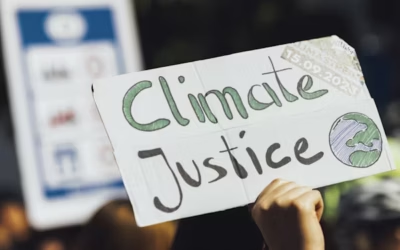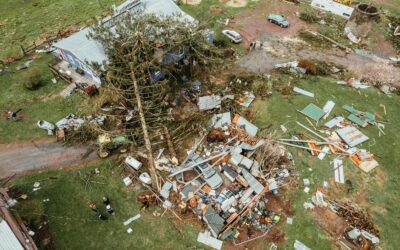by Nils Gilman in Small Precautions…In conclusion, the analysis provided by La Fabrique Écologique powerfully argues that the ecological transition in France, and likely elsewhere, is stalled not because the science is unclear or the public unwilling, but because the dominant strategies have ignored the fundamental prerequisites of social justice and economic security.
Climate crisis on track to destroy capitalism, warns top insurer
by Damian Carrington in The Guardian…Action urgently needed to save the conditions under which markets – and civilisation itself – can operate, says senior Allianz figure.
Bioregionalism in practice: Weaving local solutions in a global context
Webinar hosted by Regenerosity…This webinar kicks off a new series of bioregional conversations, designed to deepen understanding, improve practice, and expand the horizon of what’s possible when we center life, land, and community. Through stories, case studies, and grounded examples, we’ll begin to weave a vibrant patchwork of regenerative pathways forward.
Welcome to the chaoscene
by Rupert Read in aeon.com…The climate crisis is here. In order to thrive in these dangerous and precarious times, we must build resilient communities.
Bioregioning: the defining practice of regenerative cultures
by Daniel Wahl in Medium…..Bioregions define the appropriate scale for regional self-reliance, responsible environmental action and human participation in the community of life.
Ecological disruptions are a risk to national security
by Bradley J. Cardinale, et al in The Conversation…When the natural environment is stretched beyond its ability to meet basic human needs for food, clean air, drinkable water and shelter, it is not just a humanitarian concern for the world community. Research shows that these crises are a matter of national security for the U.S. and other countries.
More in this category
Three-quarters of the Earth has gotten permanently drier
by Jeffrey Kluger in Time…By century’s end, up to 20% of all Earth’s land could experience abrupt ecosystem transformation, such as forests becoming grasslands, with attendant extinction and collapse of ecosystems. Farming could suffer too.
A ‘doom loop’ of climate change and geopolitical instability is beginning
by Laurie Laybourn in The Conversation…It is a common refrain to say that geopolitics gets in the way of climate action. From the war in Ukraine to trade tensions, each year seems to bring another immediate priority that diverts focus from the imperative to act on climate change.
Does talking about climate ‘tipping points’ inspire action — or defeat?
by Kate Yoder in Grist…Kopp said that the emphasis on climate tipping points might have made sense as a call to action 20 years ago, when the consequences of climate change weren’t so obvious. But in 2024, the hottest year ever recorded, its effects are apparent, with floods, fires, and heat waves noticeably worse than they used to be.
Global emergence of regional heatwave hotspots outpaces climate model simulations
by Kai Kornhuber, et al. in PNAS…Multiple recent record-shattering weather events raise questions about the adequacy of climate models to effectively predict and prepare for unprecedented climate impacts on human life, infrastructure, and ecosystems. Here, we show that extreme heat in several regions globally is increasing significantly and faster in magnitude than what state-of-the-art climate models have predicted under present warming even after accounting for their regional summer background warming.
Trees as infrastructure
from Dark Matter Laboratories…An open source model to support municipalities in transitioning toward resilient urban forest management practices
Heat-related mortality in Europe during 2023 and the role of adaptation in protecting health
by Eliso Gallo, et al. in Nature…The year of 2023 was the warmest on record globally and the second warmest in Europe. Here we applied epidemiological models to temperature and mortality records in 823 contiguous regions from 35 countries to estimate sex- and age-specific heat-related mortality in Europe during 2023 and to quantify the mortality burden avoided by societal adaptation to rising temperatures since the year 2000.
He’ll try, but Trump can’t stop the clean energy revolution
by Matt Simon in Grist…The cost of renewables is plummeting, heat pumps are selling like crazy, and red states are raking in cash from the IRA.
Mike Davis, California’s ‘prophet of doom’, on activism in a dying world: ‘Despair is useless’
by Lois Beckett in The Guardian…lHis warnings of ecological and social breakdown have proved accurate. But with months to live, Davis is anything but defeated
The 2024 state of the climate report: Perilous times on planet Earth
by William J Ripple, et al. in BioScience…The surge in yearly climate disasters shows we are in a major crisis with worse to come if we continue with business as usual. Today, more than ever, our actions matter for the stable climate system that has supported us for thousands of years. Humanity’s future depends on our creativity, moral fiber, and perseverance.
Open letter by climate scientists to the Nordic Council of Ministers
by Climate Scientists….Many further impacts are likely to be felt globally, including a shift in tropical rainfall belts, reduced
oceanic carbon dioxide uptake (and thus faster atmospheric increase) as well as major additional sea-level rise particularly along the American Atlantic coast, and an upheaval of marine ecosystems and fisheries
Derailment risk: A systems analysis that identifies risks which could derail the sustainability transition
by Laurie Laybourn, et al. in Earth Systems Dynamics…How will the effects of climate change, nature loss, and other environmental change impact our ability to tackle the causes of these problems? There is already a high demand on resources to respond to worsening climate shocks, knock-on impacts for areas such as food production and health, and the many other growing consequences of changes to the Earth system (Pörtner et al., 2022). These impacts are expected to increase in a warmer future, placing ever greater demands on our attention and resources as we respond to worsening conditions and larger crises.
Cli-Fi—helping us manage a crisis
by Howard Frumkin in the British Medical Journal…Cli-fi may be important for our patients as they come to grips with the looming climate crisis—a hyper-object too vast to grasp, a threat too frightening to confront directly, a challenge that can feel paralysing. Indeed, health professionals may find cli-fi helpful in the same way. Cli-fi may function in at least three relevant domains: cognitive, emotional, and behavioural.
The security blind spot: Cascading climate impacts and tipping points threaten national security
by Laurie Laybourn, et al. in IPPR…Recent governments have not considered climate change a priority national security issue. But climate-security threats are non-linear and are escalating, posing profound challenges to national and international security.
Hurricane Helene isn’t an outlier. It’s a harbinger of the future.
by John Morales in The Bulletin of the Atomic Scientists…And then came the rain.
Preliminary storm-total rainfall measured on the ground included nearly 31 inches (782 millimeters) in Yancey County, northeast of Asheville, North Carolina. Radar estimated totals in areas where there were no rain gauges exceeded 40 inches (1,000 mm) just over the state line in South Carolina’s Greenville County.
How rising global heat connects catastrophic floods on four continents
by Scott Dance in The Washington Post…At this time of year, that flood potential amped up by global warming can become especially evident.



